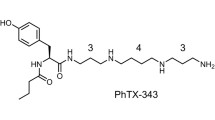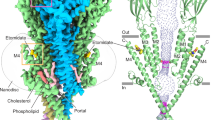Summary
-
1.
The effects of three barbiturates and the local anesthetic procaine on the ion channel function of mouse nicotinic acetylcholine receptor (nAChR) muscle subtype expressed inXenopus laevis oocytes were examined by whole-cell voltage-clamp technique.
-
2.
A concentration-response curve for the specific nicotinic agonist dimethylphenylpiperazinium iodide (DMPP) was first determined. This agonist produced increasing whole-cell currents up to a concentration of 100µM (EC50 = 13µM), then decreased responses at higher concentrations.
-
3.
The barbiturates (amobarbital, secobarbital, pentobarbital) and procaine produced reversible inhibition of DMPP-induced currents at clinically used concentrations. The two classes of drugs differed in the voltage dependence of the inhibition: procaine-induced inhibition was increased at more negative transmembrane holding potentials (-90 vs. -45 mV); whereas amobarbital-induced inhibition did not vary at different transmembrane potentials.
-
4.
Mutant forms of the nAChR, containing single amino acid changes in the M2 regions ofα andβ subunits, showed increased sensitivity to procaine but no change in sensitivity to amobarbital-induced inhibition.
-
5.
These electrophysiologic studies provide further evidence that barbiturates and local anesthetics produce inhibition of the nAChR at different sites.
Similar content being viewed by others
References
Akabas, M. H., Stauffer, D. A., Xu, M., and Karlin, A. (1992). Acetylcholine receptor channel structure probed in cysteine-substitution mutants.Science 258307–310.
Albuquerque, E. X., Kuba, K., and Daly, J. (1974). Effect of histrionicotoxin on the ion conductance modulator of the cholinergic receptor: A quantitative analysis of the end-plate current.Eur. J. Pharm. 440–46.
Albuquerque, E. X., Tsai, M.-C., Aronstam, R., Witkop, B., Eldefrawi, A. T., and Eldefrawi, M. E. (1980). Sites of action of phencyclidine. II. Interaction with the ionic channel of the nicotinic receptor.Mol. Pharm. 18167–178.
Anand, R., Conroy, W. G., Schoepfer, R., Whiting, P., and Lindstrom, J. (1991). Neuronal nicotinic acetylcholine receptors expressed inXenopus oocytes have a pentameric quaternary structure.J. Biol. Chem. 26611192–11198.
Andreasen, T. J., and McNamee, M. G. (1980). Inhibition of ion permeability control properties of acetylcholine receptor fromTorpedo californica by long-chain fatty acids.Biochemistry 194719–4726.
Bertrand, D., Ballivet, M., and Rungger, D. (1990). Activation and blocking of neuronal nicotinic acetylcholine receptors inXenopus oocytes.Proc. Natl. Acad. Sci. USA 871992–1997.
Bonta, I. L., Goorissen, F. H., and Berkx, F. H. (1968). Pharmacologic interactions between pancuronium bromide and anesthetics.Eur. J. Pharm. 483–91.
Boyd, N. D., and Cohen, J. B. (1984). Desensitization of membrane-boundTorpedo acetylcholine receptor by amine noncompetitive antagonists and aliphatic alcohols: Studies of [3H]acetylcholine binding and22Na+ ion fluxes.Biochemistry 23(18): 4023–4033.
Bradley, R., Peper, K., and Sterz, R. (1980). Postsynaptic effects of ethanol at the frog neuromuscular junction.Nature 28460–62.
Buccafusco, J. J., and Brezenoff, H. E. (1980). Opposing influences on behavior mediated by muscarinic and nicotinic receptor in the rat hypothalamic nucleus.Psychopharmacology 67249–254.
Butterworth, J. F., IV, and Strichartz, G. R. (1990). Molecular mechanisms of local anesthesia: A review.Anesthesiology 72711–734.
Changeux, J. P., Devillers-Thierry, A., and Chermouille, P. (1984). Acetylcholine receptor: an allosteric protein.Science 2251335–1345.
Changeux, J.-P., Benoit, P., Bessis, A., Cartaud, J., Devillers-Thierry, A., Fontaine, B., Galzi, J. L., Klarsfeld, A., Laufer, R., and Mulle, C. (1990). The acetylcholine receptor: functional architecture and regulation.Adv. Sec. Mess. Phospro. Res. 2415–27.
Charnet, P., Labarca, C., Leonard, R. J., Vogelaar, N. J., Czyzyk, L., Gouin, A., Davidson, N., and Lester, H. A. (1990). An open-channel blocker interacts with adjacent turns ofα-helices in the nicotinic acetylcholine receptor.Neuron 287–95.
Clark, P. B., and Kumar, R. (1983). The effects of nicotine on locomotor activity in non-tolerant and tolerant rats.Br. J. Pharmacol. 78329–337.
Cooper, E., Couturier, S., and Ballivet, M. (1991). Pentameric structure and stoichiometry of a neuronal nicotinic acetylcholine receptor.Nature 350235–238.
Crankshaw, D. P., Boyd, M. D., and Bjorksten, A. R. (1987). Plasma drug efflux—a new approach to optimization of drug infusion for constant blood concentration of thiopental and methohexital.Anesthesiology 6732–41.
Daly, J. W., Karle, J., Myers, C. W., Tokuyama, T., Waters, J. A., and Witkop, B. (1971). Histrionicotoxins: Roentgen-ray analysis of the novel allenic and acetylenic spiroalkaloids isolated from a Colombian frog,Dendrobates histrionicus.Proc. Natl. Acad. Sci. USA 681870–1875.
Dodson, B. A., and Braswell, L. M. (1991). Temperature-dependent changes in barbiturate interactions with neuronal nicotinic receptors.Ann. N.Y. Acad. Sci. 625649–652.
Dodson, B. A., Braswell, L. M., and Miller, K. W. (1987). Barbiturates bind to an allosteric regulatory site on nicotinic acetylcholine receptor-rich membranes.Mol. Pharm. 32119–126.
Dodson, B. A., Urh, R. R., and Miller, K. W. (1990). Relative potencies for barbiturate binding toTorpedo acetylcholine receptor.Br. J. Pharm. 101710–714.
Firestone, L. L., Miller, J. C., and Miller, K. W. (1986). Appendix,Molecular and Cellular Mechanisms of Anesthetics, Plenum, New York.
Forman, S. A., and Miller, K. W. (1989). Molecular sites of anesthetic action in postsynaptic nicotinic membranes.Trends Pharm Sci. 10447–452.
Gage, P. W. (1976). Generation of end-plate potentials.Physiol Rev. 56177–247.
Gage, P. W., and McKinnon, D. (1985). Effects of pentobarbitone on acetylcholine-activated channels in mammalian muscle.Br. J. Pharm. 85229–235.
Giraudat, J., Dennis, M., Heidmann, T., Haumont, Y., Lederer, F., and Changeux, J.-P. (1987). Structure of the high-affinity binding site for noncompetitive blockers of the acetylcholine receptor: [3H]Chlopromazine labels homologous residues in theβ andδ chains.Biochem. 262410–2418.
Giraudat, J., Galzi, J.-L., Revah, F., Changeux, J.-P., Haumont, P.-Y., and Lederer, F. (1989). The noncompetitive blocker [3H]chlorpromazine labels segment M2 but not segment M1 of the nicotinic acetylcholine receptorα-subunit.FEBS Lett. 253190–198.
Goldman, D., Deneris, E., Luyten, W., Kochhar, A., Patrick, J., and Heinemann, S. (1987). Members of a nicotinic acetylcholine receptor gene family are expressed in different regions of the mammalian central nervous system.Cell 48865–973.
Gundersen, C. B., Miledi, R., and Parker, I. (1984). Messenger RNA from human brain induces drug- and voltage-operated channels inXenopus oocytes.Nature 308421–424.
Gurdon, J. B., Lane, C. D., Woodland, H. R., and Marbaix, G. (1971). Use of frog eggs and oocytes for the study of messenger RNA and its translation in living cells.Nature 233177–182.
Heidmann, T., Oswald, R. E., and Changeux, J.-P. (1983). Multiple sites of action for noncompetitive blockers on acetylcholine receptor rich membrane fragments fromTorpedo marmorata.Biochemistry 223112–3127.
Herz, J. M., Johnson, D. A., and Taylor, P. (1989). Distance between the agonist and noncompetitive inhibitor sites on the nicotinic acetylcholine receptor.J. Biol. Chem. 26412439–12448.
Hollmann, M., O'Shea-Greenfield, S. W., Rogers, S. W., and Heinemann, S. (1989). Cloning by functional expression of a member of the glutamate receptor family.Nature 342643–648.
Imoto, K., Methfessel, C., Sakmann, B., Mishina, M., Mori, Y., Konno, T., Fukuda, K., Kurasaki, M., Bujo, H., Fujita, Y., and Numa, S. (1986). Location of aδ-subunit region determining ion transport through the acetylcholine receptor channel.Nature 324670–674.
Karpen J. W., and Hess, G. P. (1986). Cocaine, phencyclidine and procaine inhibition of the acetylcholine receptor: Characterization of the binding site by stopped-flow measurements of receptor-controlled ion flux in membrane vesicles.Biochemistry 251777–1785.
Koblin, D. D., and Lester, H. A. (1979). Voltage-dependent and voltage-independent blockade of acetylcholine receptors by local anesthetics inElectrophorus electroplaques.Mol. Pharm. 15559–580.
Lee-son, S., Waud, B. E., and Waud, D. R. (1975). A comparison of the potencies of a series of barbiturates at the neuromuscular junction and on the central nervous system.J. Pharmacol. Exp. Ther. 195251–256.
Leonard, R. J., Labarca, C. G., Charnet, P., Davidson, N., and Lester, H. A. (1988). Evidence that the M2 membrane-spanning region lines the ion channel pore of the nicotinic receptor.Science 2421578–1581.
Maricq, A. V., Peterson, A. S., Brake, A. J., Myers, R. M., and Julius, D. (1991). Primary structure and functional expression of the 5HT3 receptor, a serotonin-gated ion channel.Science 254432–437.
Melton, D. (1984). Efficientin vitro synthesis of biologically active RNA and RNA hybridization probes from plasmids containing a bacteriophage SP6 promoter.Nucleic Acids Res. 127035–7056.
Mishina, M., Morimoto, Y., Noda, M., Yamamoto, T., Terao, M., Lindstrom, J., Takahashi, T., Kuno, M., and Numa, S. (1984). Expression of functional acetylcholine receptor from cloned cDNAs.Nature 307604–608.
Oswald, R. E., Heidmann, T., and Changeux, J.-P. (1983). Multiple affinity states for noncompetitive blockers revealed by [3H]phencyclidine binding to acetylcholine receptor rich membrane fragments fromTorpedo marmorata.Biochemistry 223128–3136.
Pick, E. P., and Richards, G. V. (1947). Synergism of anesthetics and hypnotics with curare and curare-like agents.J. Pharmacol. Exp. Ther. 901–10.
Roth, S. H., Forman, S. A., Braswell, L. M., and Miller, K. W. (1989). Actions of pentobarbital enantiomers on nicotinic cholinergic receptors.Mol. Pharm. 36874–880.
Takeyasu, K., Shiono, S., Udgaonkar, J., Fujita, N., and Hess, G. P. (1986). Acetylcholine receptor: characterization of the voltage-dependent regulatory (inhibitory) site for acetylcholine in membrane vesicles fromTorpedo californica electroplax.Biochemistry 251770–1776.
Taylor, P. (1985). Neuromuscular blocking agents.Goodman and Gilman's The Pharmacologic Basis of Therapeutics, 7th ed., Macmillan, New York, pp. 222–235.
Thesleff, S. (1956). The effect of anesthetic agents on skeletal muscle membrane.Acta Physiol. Scand. 37335–349.
Valenzuela, C. F., Kerr, J. A., Duvvuri, P., and Johnson, D. A. (1992). Modulation of phencyclidine-sensitive ethidium binding to theTorpedo acetylcholine receptor: interaction of noncompetitive inhibitors with carbamylcholine and cobraα-toxin.Mol. Pharm. 41331–336.
Whitehouse, P. J. (1988). Specific neurochemical systems and memory.Neurobiol. Aging 9639–640.
Young, A. P., and Sigman, D. S. (1982). Allosteric effects of volatile anesthetics on the membrane-bound acetylcholine receptor protein.Mol. Pharm. 20498–505.
Author information
Authors and Affiliations
Rights and permissions
About this article
Cite this article
Yost, C.S., Dodson, B.A. Inhibition of the nicotinic acetylcholine receptor by barbiturates and by procaine: Do they act at different sites?. Cell Mol Neurobiol 13, 159–172 (1993). https://doi.org/10.1007/BF00735372
Received:
Accepted:
Issue Date:
DOI: https://doi.org/10.1007/BF00735372




